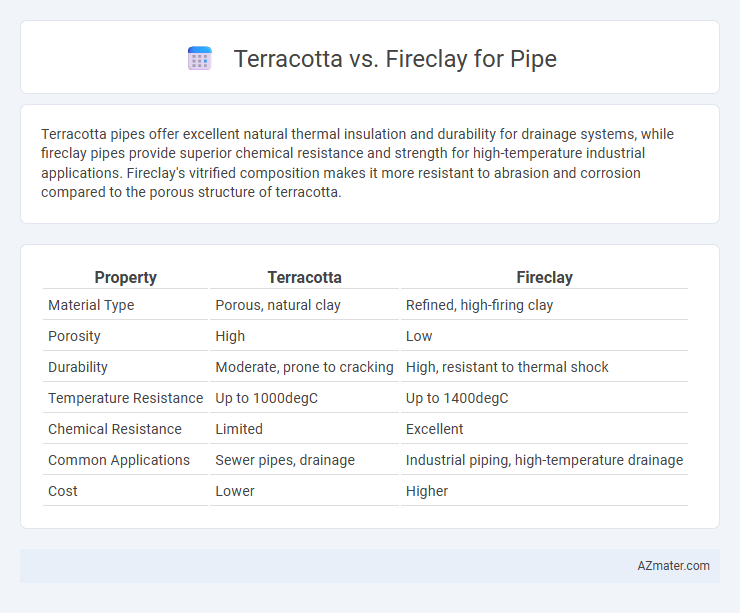Terracotta pipes offer excellent natural thermal insulation and durability for drainage systems, while fireclay pipes provide superior chemical resistance and strength for high-temperature industrial applications. Fireclay's vitrified composition makes it more resistant to abrasion and corrosion compared to the porous structure of terracotta.
Table of Comparison
| Property | Terracotta | Fireclay |
|---|---|---|
| Material Type | Porous, natural clay | Refined, high-firing clay |
| Porosity | High | Low |
| Durability | Moderate, prone to cracking | High, resistant to thermal shock |
| Temperature Resistance | Up to 1000degC | Up to 1400degC |
| Chemical Resistance | Limited | Excellent |
| Common Applications | Sewer pipes, drainage | Industrial piping, high-temperature drainage |
| Cost | Lower | Higher |
Introduction to Terracotta and Fireclay Pipes
Terracotta pipes, made from natural clay that is kiln-fired at lower temperatures, offer durability and natural resistance to chemicals, making them ideal for drainage and sewer systems. Fireclay pipes undergo firing at much higher temperatures, producing a denser, harder, and more corrosion-resistant material suited for high-pressure and abrasive environments. Both materials provide eco-friendly options for piping solutions, with fireclay excelling in strength and longevity, while terracotta remains cost-effective and widely used.
Historical Uses of Terracotta and Fireclay
Terracotta pipes have been historically favored for their ease of production, cost-effectiveness, and natural resistance to moisture, making them common in ancient water and sewage systems dating back to Mesopotamian and Roman civilizations. Fireclay pipes, known for their superior durability and resistance to high temperatures, were introduced later and became popular in industrial applications such as steam and chemical transport during the 19th and early 20th centuries. Both materials reflect ancient advancements in ceramics, but fireclay's enhanced thermal stability marked a significant evolution in pipe technology.
Material Composition and Manufacturing Processes
Terracotta pipes are primarily made from natural clay mixed with water and fired at lower temperatures, resulting in a porous and brittle structure suited for non-pressurized drainage applications. Fireclay pipes incorporate a blend of kaolin and other clays, fired at much higher temperatures, producing a dense, vitrified material with superior strength and chemical resistance ideal for sewer and industrial uses. The manufacturing of terracotta involves simpler shaping and kiln-firing methods, while fireclay requires precision molding and prolonged high-temperature firing to achieve its durable and impervious properties.
Strength and Durability Comparison
Terracotta pipes exhibit moderate strength with high resistance to chemical corrosion but are more brittle, making them prone to cracking under heavy load or impact. Fireclay pipes offer superior durability due to their dense, vitrified structure, enabling higher compressive strength and resistance to abrasion and thermal shock. Their enhanced toughness and longevity make fireclay pipes a preferable choice for high-stress drainage and sewer applications.
Resistance to Chemicals and Corrosion
Fireclay pipes exhibit superior resistance to chemicals and corrosion due to their dense, vitrified composition, making them ideal for aggressive waste and industrial effluents. Terracotta pipes, while naturally resistant to many minerals, are more porous and prone to chemical degradation over time, especially when exposed to acidic environments. The enhanced durability of fireclay under corrosive conditions extends its service life and reduces maintenance in harsh chemical applications.
Installation Methods and Ease of Use
Terracotta pipes require careful handling due to their brittle nature and typically involve jointing with mortar or specialized sealants, making installation labor-intensive and requiring skilled labor. Fireclay pipes, known for their durability and resistance to high temperatures, offer more flexibility in installation with techniques such as rubber gaskets or mechanical joints, simplifying alignment and reducing the risk of damage. Fireclay's ease of use during installation often results in faster project completion and lower labor costs compared to terracotta pipe systems.
Maintenance and Lifespan
Terracotta pipes require regular maintenance due to their porous nature, which makes them susceptible to cracking and root intrusion, potentially shortening their lifespan to around 50 years. Fireclay pipes offer superior durability and resistance to chemicals, resulting in lower maintenance needs and a lifespan that can exceed 75 years. Choosing fireclay ensures long-term performance with reduced repair frequency compared to terracotta in drainage and sewage systems.
Environmental Impact and Sustainability
Terracotta pipes, made from natural clay fired at lower temperatures, have a lower carbon footprint compared to fireclay pipes, which require higher firing temperatures and more energy-intensive production processes. Fireclay pipes, while more durable and resistant to chemical corrosion, often involve resource-intensive mining and processing, increasing their environmental impact. Terracotta's biodegradability and potential for reuse contribute to its sustainability, whereas fireclay's longer lifespan can reduce frequency of replacement but at the cost of higher initial environmental burden.
Cost Differences and Value for Money
Terracotta pipes typically cost less upfront than fireclay pipes but offer lower durability and a shorter lifespan, which may increase long-term maintenance expenses. Fireclay pipes, while more expensive initially due to their high density and resistance to chemicals and abrasion, provide superior longevity and lower replacement frequency, resulting in better value for money over time. Choosing between the two depends on budget constraints and the importance of long-term performance and durability.
Choosing the Right Pipe Material for Your Project
Choosing between terracotta and fireclay pipes depends on durability, cost, and application requirements. Terracotta pipes offer affordability and natural corrosion resistance, making them suitable for drainage and sewer systems, while fireclay pipes provide superior strength and heat resistance ideal for industrial or high-temperature environments. Evaluating factors such as soil conditions, load-bearing capacity, and temperature exposure ensures selection of the most effective pipe material for long-term performance.

Infographic: Terracotta vs Fireclay for Pipe
 azmater.com
azmater.com